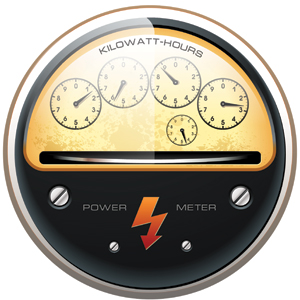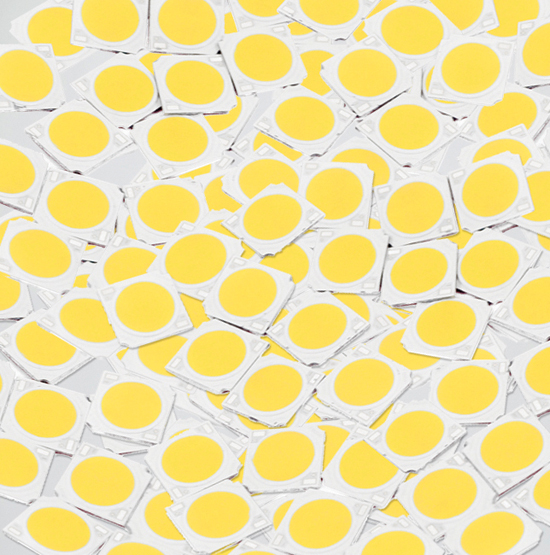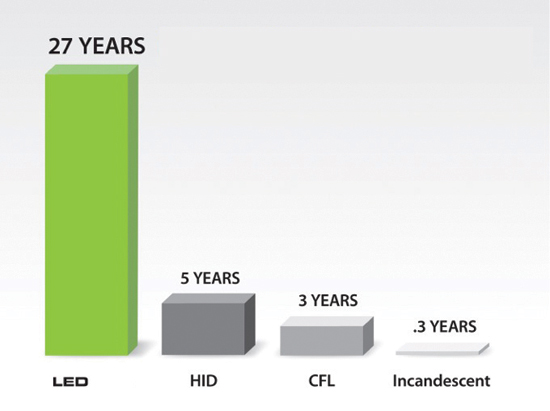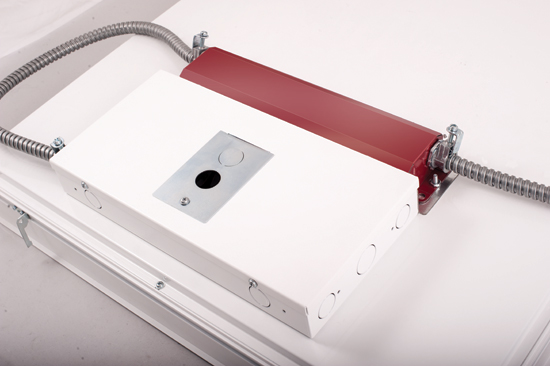LED Lighting for Commercial Ceilings
The time portion of this equation is obviously governed by a whole series of variables. The building location, usage, daylighting options, management policies, and most notably, human input all can work to positively optimize or negatively maximize the amount of time that the lights are on. Energy codes address this variable by calling for automatic means to turn off lights when spaces are not occupied or when the building is closed, with security and safety lighting given due consideration. The ability to turn off or dim down electrical lighting systems when not needed is recognized as a key contributor to minimizing environmental impact. While lighting controls are an important topic due to the impact they can have on overall energy use, we will focus here primarily on the energy needed (watts) for commercial lighting and leave controls for another article.
 |
Electricity use for lighting is a function of both power consumed (kilowatts) and time (hours) that the lights are on. Image courtesy of RAB Lighting, Inc. |
Most commercial lighting fixtures have several parts, all of which contribute to the ultimate total energy consumption discussed as follows:
Lamp or Light Source
The primary power consumption in commercial light fixtures is the light source commonly referred to as a bulb or lamp. There are four common types of lamps used in commercial buildings, namely incandescent/halogen lamps, fluorescent lamps, HID lamps, and LED lamps.
• Incandescent and halogen lamps: Dating back to the early 1900s, these lamps employ the oldest basic technology in use today for lighting. These lamps are sometimes used for highlighting or spot-lighting particular areas in commercial areas. Pressed glass aluminized reflector (PAR) lamps are an example of this type that can use either a tungsten incandescent filament or a tungsten halogen combination that creates a longer-lasting, brighter light. Hence, their respective abbreviated common names of incandescent or halogen lamp.
• Fluorescent lamps: Fluorescent lamps were first introduced in 1939 and have gained great popularity in commercial buildings ever since. They create light when an electric arc passes through inert gas and mercury contained in a glass tube that is coated with phosphor on the inside. The tubes are available in a variety of shapes and sizes, including the common 4-foot and 8-foot linear lamps, U-shaped, and round. In contrast to these fluorescent lamps, compact fluorescent lamps (CFL) were introduced in the 1980s in a form that offered a new range of compact shapes with dictated socketing or screws—in bases like a traditional incandescent bulb.
• High-intensity discharge (HID) lamps: Originally referred to as mercury lamps in the 1930s, they were trumped in the 1960s by metal halide and high-pressure sodium (HPS) technology. In each case, the glass enclosure is under pressure with an electric arc used to create a very bright point source of light that can, with the help of a reflector, project a far distance, making them well suited for high ceilings. This process of producing light requires some time to both start up and cool down, however.
• Light-emitting diodes (LEDs): Unlike all of the other lamps described, an LED uses a solid-state semiconductor to convert electrons (electrical energy) directly into photons (light). This means that an LED uses no heavy metals like mercury or lead, uses no gas, and needs no filament to operate. Because of its electronic nature, there are no moving parts that can fail and it does not require a fragile glass bulb. Colored LEDs became common in the 1960s and '70s and were used in electronic devices such as watches and calculators. By the 1990s they were being used in exit signs and traffic lights as clear LEDs became available and their brightness increased. Currently LEDs are available in a full range of colors and can be clustered together in bulbs or fixtures to create a complete light source.
 |
Light-emitting diodes (LEDs) are a low-energy, high-output light source that work by using solid-state electronics to change electricity into light. Photo courtesy of RAB Lighting, Inc. |
In addition to the differences in the development and physical characteristics of each of these lamps, there is also a notable difference in the amount of energy that each one requires to produce equivalent amounts of light. The unit of measurement that describes the quantity of light emitted from a source of light is called a lumen. Different lamps are usually compared based on the amount of lumens of light that they produce for each watt of electricity they consume. This measure of lumens per watt (lm/W) is the lamp's “efficacy” (sometimes incorrectly called efficiency) and is similar to a “miles per gallon” rating for cars. The higher the rating, the more output that is achieved (e.g. light or miles) compared to the energy put in (e.g. electricity or gasoline). It should be noted that just as an older car may get worse gas mileage, the lumen output of most lamps drops off over time by as much as 20 to 30 percent for incandescent and fluorescent lamps.
Looking at the four categories of lamps, incandescent and halogen receive the lowest efficacy, meaning they need a lot of energy to produce their light output. This is in part due to the fact that up to 90 percent of the electricity gets turned into heat rather than light. Fluorescent lamps are notably cooler and perform much better, particularly with advances made in the past decade such that a common 40-watt linear tube now usually only requires 28 or 32 lamp watts to produce the same lumen output. HID lamps typically produce a great deal of light, so their lm/W rating is usually favorable, but they aren't always appropriate choices in many locations due to poor color rendering and lack of beam control without a reflector. LED lamps are known for their low energy needs, good color rendering, precise beam control, being cool to the touch, and most importantly, their efficacy is commonly superior to the other lamp types.
One other characteristic of different lamp types is their average rated life. Manufacturers will test representative lamps and determine how many hours they will continue to work until they “burn out” or no longer provide light. The average is computed based on this testing and the manufacturers can indicate a rating of their average life expectancy. Incandescent and halogen lamps are often rated for approximately 1,000 to 2,500 hours. Fluorescent and HID lamps are rated from 6,000 to 24,000 hours, meaning in an average commercial facility with the lights on 10 hours a day, they could last anywhere from 2 to 6 years before needing to be replaced, assuming that their light quality and efficacy remain high. However, modern fluorescent lamps, such as T5, T8, and T12 versions, all have significant lumen depreciation over time.
LEDs clearly lead the way in terms of average rated life. They are rated between 50,000 and 100,000 hours, meaning that they could easily operate effectively between 12 to 27 years. This rating is based not on the LED lamps “burning out” but rather losing light output to the point that it is perceptible to people. L70 is an industry standard to express the useful lifespan of an LED. It indicates the number of hours before light output drops to 70 percent of initial output. Hence their long average rated life is based on the average number of hours (years) that it will take to reach this 70 percent light reduction. With that type of longevity and lumen maintenance, there is no need to store spare lamps or to replace them, thus freeing up maintenance budgets and storage costs.
Lamp Ballasts and Drivers
Since fluorescent and HID lamps require a controlled arc of electricity to create light, a ballast is used to control and limit the flow of electricity during start up and operation. Without them, large amounts of electricity would flow in to create the arc in an unrestricted way.
There are two types of ballasts that are commonly used. Electromagnetic ballasts were the original type used when fluorescent lights were first made available. These ballasts are essentially an electrical transformer with a steel core that is wrapped with wire and placed in a metal housing. These components work together to choke or limit the amount of current that goes into the lamp. In the process, they also produce unwanted heat and noise so they are commonly wrapped in asphalt to conduct the heat away, reduce noise, and help improve longevity.
The second and more common type used today is an electronic ballast. In this case, solid-state circuitry is relied upon to dampen and control the flow of electricity to the lamp. Electronic ballasts allow the electrical current to flow at a much higher frequency (20,000 Hz for electronic vs. 120 Hz for magnetic ballasts), reducing any audible noise while also operating at cooler temperatures. Although they are commonly more expensive than electromagnetic ballasts, they are more efficient and more flexible such that the overall benefits are worth the small additional cost. In fact, it is safe to say that almost all new light fixtures are produced with electronic ballasts except for some that need a heavy-duty or temperature-tolerant ballast based on their location.
 |
A comparison of the rated lifespan of different lamp types based on 10-hour-per-day operation. Source: RAB Lighting, Inc. |
Ballasts can allow fluorescent lights to be dimmed, although the percent of dimming will depend on the type of ballast. Electronic ballasts can readily dim lamps down to 10 percent, 5 percent, and even 1 percent of full light output while electromagnetic ballasts generally are limited to 50 percent dimming. As the fluorescent lamps are dimmed down, they use less energy, making them particularly useful in situations where daylighting is designed into a space and photo-sensors trigger the dimming process.
From an energy standpoint, not all ballasts are created equal. Since they are located in the flow of electricity, they use and consume some energy in the process of conditioning it. Electronic ballasts are more efficient and consume less energy than the electromagnetic type, causing energy codes to favor them as a result. Recognizing this consumption, ballasts are tested and rated to determine the ballast factor (BF), which is simply the percentage of a lamp's rated lumen output that can be expected when it is operated on a specific ballast. So, for example, a ballast with a BF rating of 0.90 results in the lamp emitting 90 percent of its rated lumen output. Since the ballast is part of the overall lighting system with component parts that work together, this light reduction obviously plays into the overall lighting of the room or space in the building.
LED lighting does not require ballasts—relying instead on an electronic driver to condition and control the electricity. The driver uses a negligible amount of electricity to operate, making it much more efficient than ballasts. Drivers are rated for overall power factor similar to rating ballasts; however since drivers use so little energy, their power factors are commonly over 99 percent. LED lights are also dimmable, using dimmable drivers which allow the amount of light and energy to be reduced electronically.
 |
A driver for an LED fixture is a small thin unit that can be mounted to an LED light fixture. The red portion shown next to the driver is a back-up battery option for emergency lighting. Photo courtesy of RAB Lighting, Inc. |









